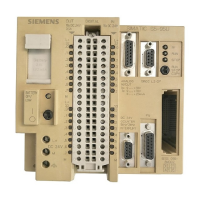Description of the Firmware
4–21
IP244
C79000–B8576–C860–02
1.2.4 Which Controlled Systems Can the Self-Tuning Function
be Used With?
The self-tuning function can be used with systems which meet the following conditions:
The system must display a low pass response. This condition is generally met by
temperature processes.
The control system must allow for the following temperature jump:
at least 37 °C with 2Ćstep controllers,
at least 37 °C up to 110 °C with 2Ćstep controllers.
The maximum rate of rise of the actual value must not exceed 60 °C/min with full heating
power or with simultaneous full heating and cooling power.
The maximum rise of the actual value must be 0.05 °C/min with full heating power.
The heating procedure must not require more than 12 hours.
With pure Pt 100 operation only 11.6 h is permitted.
With mixed operation and one
standard controller
– and ADC conversion time = 50 ms, only 7.2 h permitted
– and ADC conversion time = 60 ms, only 8.7 h permitted.
If only the cooling is active, you must guarantee that the actual value falls.
A further condition for calculating the cooling parameters is that the actual value must not
fall faster than 60 °C/min while the selfĆtuning function is heating and cooling
simultaneously.
Suitable for systems in which no large stepĆlike disturbances (in the automation control sense)
occur.
To convert to degrees Fahrenheit T [ F] = (T C] x1.8 + 32).
1.2.5 Assigning Parameters for the Self-Tuning Function
Each of the 13 temperature controllers can be assigned parameters to operate as a standard or
self-tuning temperature controller. This allows mixed controlled systems, some meeting the
required conditions and some not meeting the required conditions, to be operated with one
temperature controller module.
The self-tuning function is specified in messages 0 to 12 in the ”self-tuning” byte (byte 22).
The self-tuning function and the end of the self-tuning phase are indicated in a separate bit for
heating and cooling.
If only heating parameters and no cooling parameters have been calculated for a 3-step controller,
this is also indicated and a value for the required temperature jump is calculated and indicated to
the user.
While a controller is running with selfĆtuning function and determines parameters, it can
only be accessed by reading (if you try to assign parameters to the controller, the message
"parameter error" is output at the FB 162).

